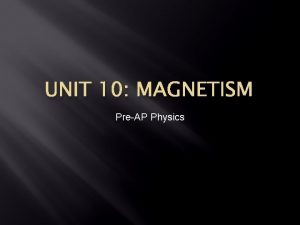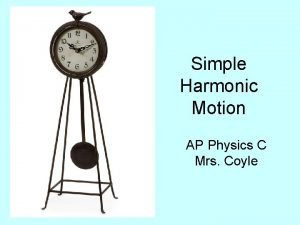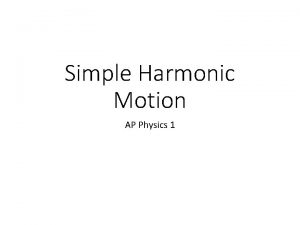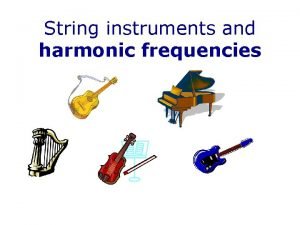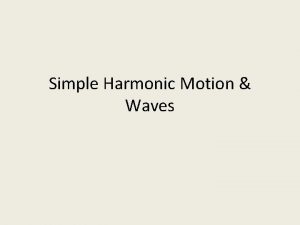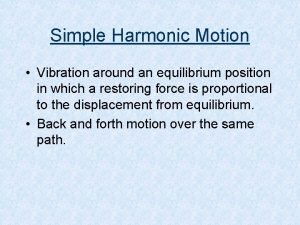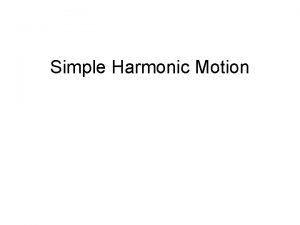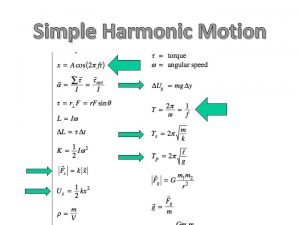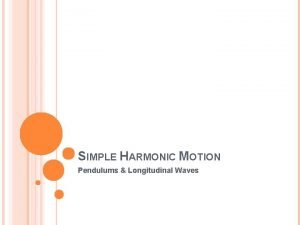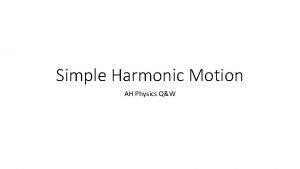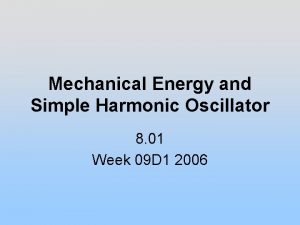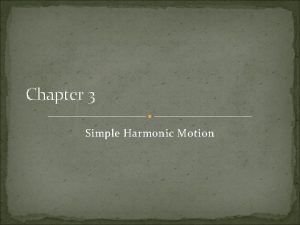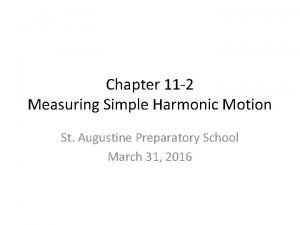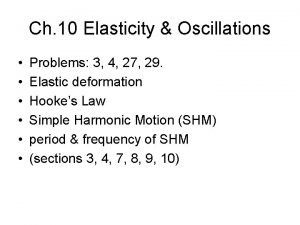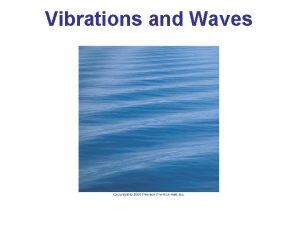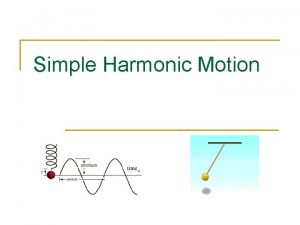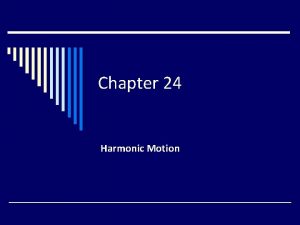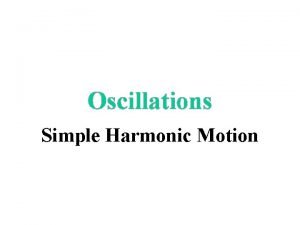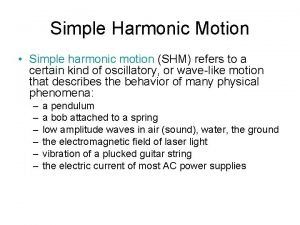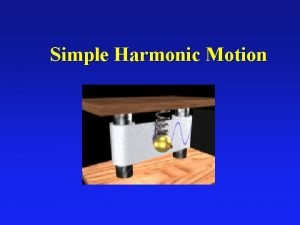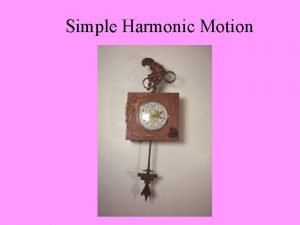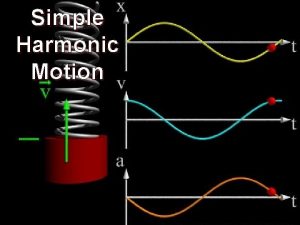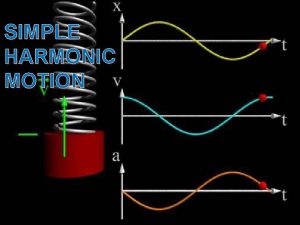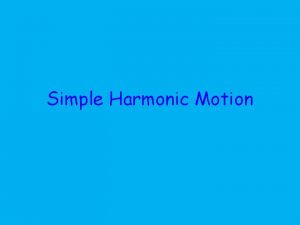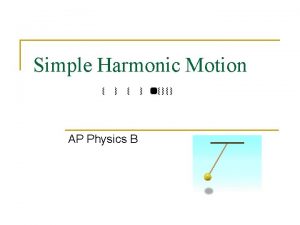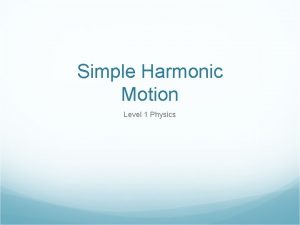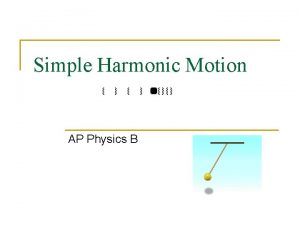Simple Harmonic Motion PreAP Physics Simple Harmonic Motion

















- Slides: 17

Simple Harmonic Motion Pre-AP Physics

Simple Harmonic Motion simple harmonic motion (SHM) – vibration about an equilibrium position in which a restoring force is proportional to the displacement from equilibrium ¢ two common types of SHM are a vibrating spring and an oscillating pendulum ¢ springs can vibrate horizontally (on a frictionless surface) or vertically ¢

Oscillating Spring

SHM and Oscillating Springs in an oscillating spring, maximum velocity (with Felastic = 0) is experienced at the equilibrium point; as the spring moves away from the equilibrium point, the spring begins to exert a force that causes the velocity to decrease ¢ the force exerted is maximum when the spring is at maximum displacement (either compressed or stretched) ¢

SHM and Oscillating Springs at maximum displacement, the velocity is zero; since the spring is either stretched or compressed at this point, a force is again exerted to start the motion over again ¢ in an ideal system, the mass-spring system would oscillate indefinitely ¢

SHM and Oscillating Springs damping occurs when friction slows the motion of the vibrating mass, which causes the system to come to rest after a period of time ¢ if we observe a mass-spring system over a short period of time, damping is minimal and we can assume an ideal mass-spring system ¢

SHM and Oscillating Springs in a mass-spring system, the spring force is always trying to pull or push the mass back toward equilibrium; because of this, we call this force a restoring force ¢ in SHM, the restoring force is proportional to the mass’ displacement; this results in all SHM to be a simple back-and-forth motion over the same path ¢

Hooke’s Law in 1678, Robert Hooke proposed this simple relationship between force and displacement; Hooke’s Law is described as: Felastic = -kx ¢ where Felastic is the spring force, ¢ k is the spring constant ¢ x is the maximum displacement from equilibrium ¢

Hooke’s Law ¢ ¢ the negative sign shows us that the force is a restoring force, always moving the object back to its equilibrium position the spring constant has units of Newtons/meter the spring constant tells us how resistant a spring is to being compressed or stretched (how many Newtons of force are required to stretch or compress the spring 1 meter) when stretched or compressed, a spring has potential energy

Simple Pendulum ¢ simple pendulum – consists of a mass (called a bob) that is attached to a fixed string; we assume that the mass of the bob is concentrated at a point at the center of mass of the bob and the mass of the string is negligible; we also disregard friction and air resistance

Simple Pendulum

Simple Pendulum for small amplitude angles (less than 15°), a pendulum exhibits SHM ¢ at maximum displacement from equilibrium, a pendulum bob has maximum potential energy; at equilibrium, this PE has been converted to KE ¢ amplitude – the maximum displacement from equilibrium ¢

Period and Frequency period (T) – the time, in seconds, to execute one complete cycle of motion; units are seconds per 1 cycle ¢ frequency (f) – the number of complete cycles of motion that occur in one second; units are cycles per 1 second (also called hertz) ¢

Period and Frequency ¢ frequency is the reciprocal of period, so ¢ the period of a simple pendulum depends on the length of the string and the value for free -fall acceleration (in most cases, gravity)

Period of a Simple Pendulum ¢ notice that only length of the string and the value for free-fall acceleration affect the period of the pendulum; period is independent of the mass of the bob or the amplitude

Period of a Mass-Spring System ¢ period of a mass-spring system depends on mass and the spring constant ¢ notice that only the mass and the spring constant affect the period of a spring; period is independent of amplitude (only for springs that obey Hooke’s Law)

Comparison of a Pendulum and an Oscillating Spring
 Preap magnetism 1
Preap magnetism 1 Preap
Preap Periodic motion formula
Periodic motion formula Ap physics 1 simple harmonic motion
Ap physics 1 simple harmonic motion Harmonic motion equation
Harmonic motion equation Tension wave
Tension wave Simple harmonic motion vocabulary
Simple harmonic motion vocabulary Equilibrium position of a wave
Equilibrium position of a wave How to find the restoring force of a spring
How to find the restoring force of a spring Reference circle shm
Reference circle shm Simple harmonic motion formula
Simple harmonic motion formula Harmoninic ah
Harmoninic ah Shm equations
Shm equations Simple harmonic motion formula
Simple harmonic motion formula Simple harmonic motion
Simple harmonic motion A 125 n object vibrates
A 125 n object vibrates Frequency in simple harmonic motion
Frequency in simple harmonic motion Simple harmonic motion formula
Simple harmonic motion formula
